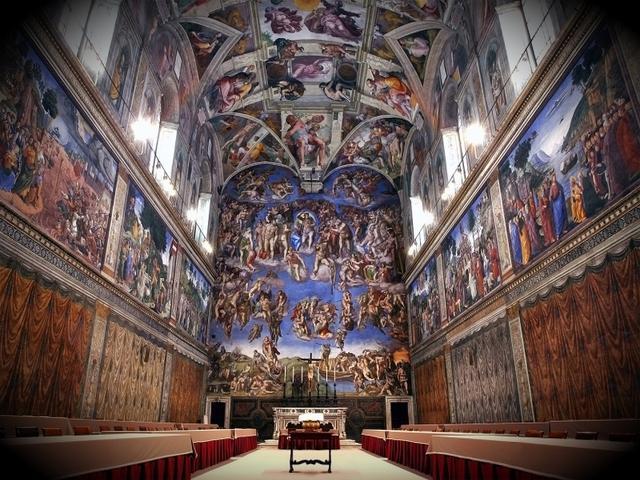Sistine Chapel

The Sistine Chapel is undoubtedly one of the most iconic and breathtaking landmarks in the world, located within the Vatican Museums in Vatican City. It is a masterpiece of Renaissance art and architecture, showcasing the incredible talent and creativity of some of the most renowned artists in history. The chapel's history dates back to the late 15th century when Pope Sixtus IV commissioned its construction as a place of worship and reflection. Over the centuries, it has undergone various stages of construction, renovation, and restoration, each adding to its grandeur and significance.
The architectural structure of the Sistine Chapel is reminiscent of a medieval defensive fortress, designed by Baccio Pontelli and executed by Giovannino de' Dolci. The interior is adorned with intricate details and decorations, including a stunning Cosmatesco-style floor, a choir on the right side for musical accompaniment during religious ceremonies, and a marble dividing wall adorned with cherubs holding the coat of arms of the della Rovere family. These elements create a sense of grandeur and reverence, setting the stage for the incredible artwork that adorns the chapel's walls and ceiling.
The most famous and awe-inspiring feature of the Sistine Chapel is undoubtedly the series of frescoes that cover its walls and ceiling. The frescoes were created in three different periods by a group of talented artists, including Perugino, Sandro Botticelli, Domenico Ghirlandaio, and Cosimo Roselli, under the supervision of two papal theologians. The frescoes depict a wide range of biblical scenes, from the stories of Jesus to the lives of the apostles and the early popes of the church. Each fresco is a masterpiece in its own right, showcasing the artists' skill and creativity in bringing these stories to life.
One of the most famous works of art in the Sistine Chapel is Michelangelo's stunning ceiling frescoes, which he painted over a period of four years from 1508 to 1512. The ceiling is divided into nine panels, each depicting a different scene from the Book of Genesis, including the creation of Adam and Eve, the fall of man, and the story of Noah's Ark. Michelangelo's mastery of anatomy and perspective is evident in every brushstroke, creating a sense of depth and movement that is truly awe-inspiring.
In addition to the ceiling frescoes, Michelangelo also created the monumental fresco of the Last Judgment on the altar wall of the chapel between 1535 and 1541. This powerful and dramatic depiction of the final judgment is a testament to Michelangelo's skill as a painter and his deep understanding of human emotion and spirituality. The fresco is filled with dynamic figures and intense emotions, capturing the moment of divine judgment with a sense of urgency and drama that is unparalleled in the history of art.
Overall, the Sistine Chapel is a true marvel of human creativity and ingenuity, a place where art, religion, and history converge to create an unforgettable experience for visitors from around the world. Whether you are an art enthusiast, a history buff, or a spiritual seeker, a visit to the Sistine Chapel is sure to leave you in awe of the beauty and brilliance of the human spirit.
© ChatGPT 3.5
*Initially, when Michelangelo was summoned to paint the Sistine Chapel, he opposed it, as the dimensions of the commission seemed intimidating and, arguing that he considered himself a sculptor rather than a painter, he said no to the project. Finally, and as a good fan of challenges, he accepted.
*From 1508 until the fall of 1512, Michelangelo worked alone on the work, without the help of assistants.
*Although the Sistine Chapel frescoes have been restored on some occasions, the experts who carried out the work left some small sections uncleaned, specifically around the Last Judgment scene, so that the viewer can appreciate the contrast between the state original of the paintings and the one they acquired after the restoration.
*Antonio Paolucci, director of the Vatican Museums, said that the sweat, skin flakes and carbon dioxide exhaled by those attending the Sistine Chapel represent a big problem for the restored frescoes.